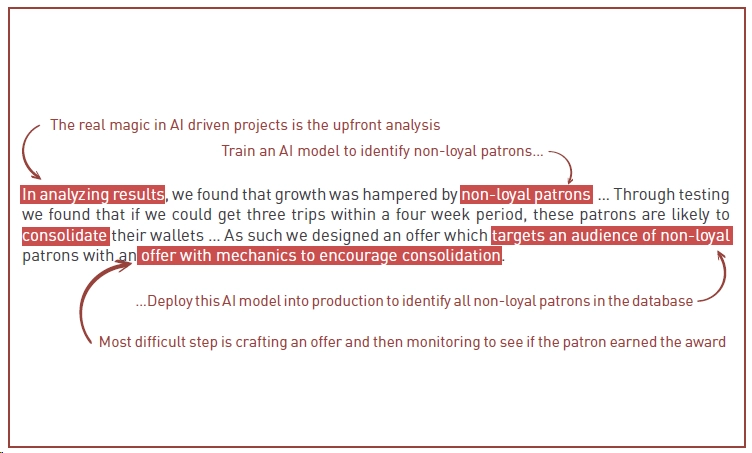In the first of a series of articles, Clayton Peister and Kasra Ghaharian explore how operators can make sense of artificial intelligence and its practical applications in the casino industry.
We work with operators around the globe to solve many of the industry’s most complicated and intractable problems like marketing efficiency, fraud, responsible gaming and asset optimization. These projects typically require some degree of artificial intelligence (AI). We recently attended G2E Asia and spoke at length with many operators who are trying to wrap their hands around AI and parse the hype from reality. FOMO was often lurking in the shadows.
 With this the first article in a series about AI in the gaming industry, we will attempt to make AI more approachable for operators; the series is informed by our journey as both an AI practitioner and an advisor helping operators adopt AI solutions. In order to understand the promise AI embodies, we think it is important to address the role of AI in a very specific sense and the myths cloaking this emerging technology.
With this the first article in a series about AI in the gaming industry, we will attempt to make AI more approachable for operators; the series is informed by our journey as both an AI practitioner and an advisor helping operators adopt AI solutions. In order to understand the promise AI embodies, we think it is important to address the role of AI in a very specific sense and the myths cloaking this emerging technology.
What does AI actually do?
To see the role of AI in solving a specific problem, let’s use a case study from a recent project with a tribal client. In analyzing results, we found that growth was hampered by non-loyal patrons, and surveying confirmed these patrons were splitting their wallets. Through testing we found that if we could get three trips within a four-week period, these patrons were likely to consolidate their wallets at the client property. As such we designed an offer which targets an audience of non-loyal patrons with an offer with mechanics to encourage consolidation. Let’s diagram that problem:
 In this simplified example, AI fills an important but narrow role by identifying patrons who are non-loyal. But human creativity is equally important. Bear in mind, this is a simplified example, and most operators would also create a model to set the number of visits required within the period as well as another model to set the reinvestment and reward. The overarching theme is the same: AI facilitates personalization at scale. AI extracts patterns from the players we know a lot about, and then applies those patterns to people we know little about or have limited history of.
In this simplified example, AI fills an important but narrow role by identifying patrons who are non-loyal. But human creativity is equally important. Bear in mind, this is a simplified example, and most operators would also create a model to set the number of visits required within the period as well as another model to set the reinvestment and reward. The overarching theme is the same: AI facilitates personalization at scale. AI extracts patterns from the players we know a lot about, and then applies those patterns to people we know little about or have limited history of.
Common misconceptions about AI
Misconception one: the application of AI
One of the authors spoke at a conference on the applications of AI within the casino industry. The conference was bookended by one speaker who recommended using AI to make paint selections while the last speaker (representing a big vendor) recommended that operators should use AI to design players’ marketing offers. AI, in our experience, is about personalization at scale but is not magic. Well, at least not yet. As such, neither example above is appropriate, but these misguided anecdotes illustrate the confusion around AI. Continuing with the above example, host experience is likely a better judge of player loyalty than an AI model, but host knowledge can’t be scaled to the entire or even to most databases.
Of course, AI provides immense opportunities to operators that can help drive business value and efficiencies. Taken too far, however, AI could actually harm players. We can imagine a scenario where AI, perhaps inadvertently, correlates compulsive behaviors with growth, for instance.
We should therefore recognize the potential of the AI technology across other use-cases such as compliance and responsible gaming. In terms of responsible gaming, with the number of player interactions with various technologies throughout the customer journey, there is now an abundance of data that can bolster consumer protection efforts. Bet by bet transactional information from slot machines as well as emerging data points from RFID technology and cashless solutions provide rich behavioral data that can be analyzed with AI to model patterns of behavior that could indicate potentially harmful play. As part of IGI’s Payments Research Collaborative we used machine learning, a subset of AI, to identify behavioral markers of harm from customers’ deposit and withdrawal activity. Thus, AI has what could be described as a “dual use” in gaming, and it is important for operators to balance the benefits and risks posed by these various applications of AI.
Misconception two: AI is hard
In our work with casino operators globally, another misconception we often encounter – and one that will surely resonate with IAG’s readers – is that AI is technically difficult and requires experts. We typically begin AI projects with the following thought exercise. When we talk about AI, we are really talking about predictive models and the first predictive model most people learn around the age of eight: the average. With only a few examples, predictive models are just a more sophisticated way of estimating expected behavior (i.e. an average) given a set of known attributes about a person. While the average is just one of hundreds of predictive modelling algorithms, recent advances in automated machine learning can select the best algorithms and optimal settings; no advanced degree required. And GenAI is drastically reducing the learning curve for coding.
Misconception three: accounting level accuracy
What is a leap for most properties is cultural rather than technical. We recently supported an operator who is an early adopter of a casino AI platform. In our marketing strategy presentation to this operator, we recommended using the churn predictions being generated by their AI application to develop a win-back campaign. The operators feedback was noncommittal but also not uncommon: “We look at these predictions, but we can’t actually use them as they are just a guess.”
Adopting AI driven marketing requires accepting that sometimes the predictions will be wrong and the more times these predictions are right the more money the property will earn.
Misconception four: casinos have bad data
While this is undoubtedly true even on slots, in the wake of online gaming proliferation several vendors are collecting more bet level transactions and bringing more accuracy to the beleaguered ratings. While ratings are nearly always wrong, they are consistently wrong, which makes ratings useful. In addition to player session ratings, properties collect detailed information on comping behavior and perhaps non-gaming activity, not only outlets but also menu items. These are rich data and historically the challenge has been federating and making sense of these data sources. Data, of course, is foundational and is the subject of our next article.
Approach
Most properties start the AI journey by recruiting a data scientist. We have found the best results by empowering an entrepreneurial analyst who already knows the business. Low- and no-code solutions exist, many of which emulate how analysts currently think about problems, versus how software engineers write software. Likewise, we recommend starting with an easier use case like a win-back campaign and running smaller trial campaigns to independently distill the impact of the algorithm versus the offer. As these predictions change slowly, implementation is through easier predictions updated nightly. The emergence of real-time data makes situational recommendations more important, like responsible gaming predictions, but even so the nightly process is the foundation for real-time predictions. Typically, the next step in the journey is to migrate from predictive modelling into machine learning models which can self-learn and refine overtime with deep painstaking intervention.





























